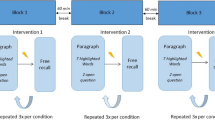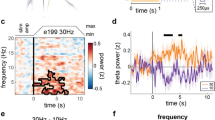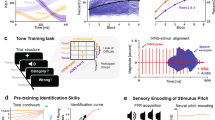Abstract
Neuromodulators associated with arousal modulate learning and memory, but most of these substances do not freely enter the brain from the periphery. In rodents, these neuromodulators act in part by initiating neural messages that travel via the vagus nerve to the brain, and electrical stimulation of the vagus enhances memory. We now extend that finding to human verbal learning. We examined word-recognition memory in patients enrolled in a clinical study evaluating the capacity of vagus nerve stimulation to control epilepsy. Stimulation administered after learning significantly enhanced retention. These findings confirm in humans the hypothesis that vagus nerve activation modulates memory formation similarly to arousal.
This is a preview of subscription content, access via your institution
Access options
Subscribe to this journal
Receive 12 print issues and online access
$209.00 per year
only $17.42 per issue
Buy this article
- Purchase on Springer Link
- Instant access to full article PDF
Prices may be subject to local taxes which are calculated during checkout

Similar content being viewed by others
References
Eysenck, M. W. Attention and Arousal (Springer-Verlag, Berlin, 1982 ).
McGaugh, J. L. Time-dependent processes in memory storage. Science 153, 1351–1358 (1966).
McGaugh, J. L. Involvement of hormonal and neuromodulatory systems in the regulation of memory storage. Annu. Rev. Neurosci. 12, 255– 287 (1989).
Cahill, L. & McGaugh, J. L. Modulation of memory storage. Curr. Opin. Neurobiol. 6, 237– 242 (1996).
Cahill, L., Prins, B., Weber, M. & McGaugh, J. L. Beta-adrenergic activation and memory for emotional events. Nature 371, 702–704 (1994).
Nielson, K. A. & Jensen, R. A. Beta-adrenergic receptor antagonist antihypertensive medications impair arousal-induced modulation of working memory in elderly humans. Behav. Neural Biol. 62, 190–200 (1994).
Broadhurst, P. L. Emotionality and the Yerkes-Dodson law. J. Exp. Psychol. 54, 345–352 (1957).
Hebb, D. O. Drive and the C.N.S. (Conceptual Nervous System). Psychol. Rev. 62, 243–253 ( 1955).
Yerkes, R. M. & Dodson, J. D. The relation of strength of stimulus to rapidity of habit-formation. J. Comp. Neurol. Psychol. 18, 459–482 (1908).
Williams, C. L. & Jensen, R. A. in Neuronal Control of Bodily Function, Basic, and Clinical Aspects: Vol. 6 Peripheral Signaling of the Brain: Role of Neural-Immune Interactions, Learning and Memory (eds Frederickson, R. C. A., McGaugh, J. L. & Felton, D. L.) 467–472 (Hogrefe & Huber, Toronto, 1991).
Williams, C. L. & Jensen, R. A. Effects of vagotomy on leu-enkephalin-induced changes in memory storage processes. Physiol. Behav. 54, 659–663 (1993).
Flood, J. F., Smith, G. E. & Morley, J. E. Modulation of memory storage processing by cholecystokinin: Dependence on the vagus nerve. Science 234, 832–834 (1987).
Nogueira, P. J. C., Tomaz, C. & Williams, C. L. Contribution of the vagus nerve in mediating the memory-facilitating effects of substance P. Behav. Brain Res. 62, 165–169 (1994).
Williams, C. L. & McGaugh, J. L. Reversible lesions of the nucleus of the solitary tract attenuate the memory-modulating effects of posttraining epinephrine. Behav. Neurosci. 107, 955–962 (1993).
Clark, K. B., Krahl, S. E., Smith, D. C. & Jensen, R. A. Post-training unilateral vagal stimulation enhances retention performance in the rat. Neurobiol. Learn. Mem. 63, 213 –216 (1995).
Clark, K. B. et al. Post-training electrical stimulation of vagal afferents with concomitant vagal efferent inactivation enhances memory storage processes in the rat. Neurobiol. Learn. Mem. 70, 364 –373 (1998).
Nielson, K. A., Radtke, R. C. & Jensen, R. A. Arousal-induced modulation of memory storage processes in humans. Neurobiol. Learn. Mem. 66, 133 –142 (1996).
Woodbury, D. M. & Woodbury, J. W. Effects of vagal stimulation on experimentally induced seizures in rats. Epilepsia 31, S7–S19 ( 1990).
Woodbury, J. W. & Woodbury, D. M. Vagal stimulation reduces the severity of maximal electroshock seizures in intact rats: Use of a cuff electrode for stimulating and recording. Pacing Clin. Electrophysiol. 14, 94–107 (1991).
Lockard, J. S., Congdon, W. C. & DuCharme, L. L. Feasibility and safety of vagal stimulation in a monkey model. Epilepsia 31, S20– S26 (1990).
Zabara, J. Inhibition of experimental seizures in canines by repetitive vagal stimulation. Epilepsia 33, 1005–1012 (1992).
Penry, J. K. & Dean, J. C. Prevention of intractable partial seizures by intermittent vagal stimulation in humans: Preliminary results. Epilepsia 31, S40–S43 (1990).
Ben-Menachem, E. et al. Vagus nerve stimulation for treatment of partial seizures: 1. A controlled study of effect on seizures. Epilepsia 35, 515–526 (1994).
Vagus Nerve Stimulation Study Group. A randomized controlled trial of chronic vagus nerve stimulation for treatment of medically intractable seizures. Neurology 45, 224–230 (1995).
Armour, J. A., Wurster, R. D. & Randall, W. C. in Neural Regulation of the Heart (ed. Randall, W. C.) 159–186 (Oxford, New York, 1977).
Paintal, A. S. Vagal sensory receptors and their reflex effects. Physiol. Rev. 53, 159–227 ( 1973).
Curry, D. L. Reflex inhibition of insulin secretion: Vagus nerve involvement via CNS. Am. J. Physiol. 247, 827–832 (1984).
Cechetto, D. F. Central representations of visceral function. Fed. Proc. 46, 17–23 (1986).
Rutecki, P. Anatomical, physiological, and theoretical basis for the antiepileptic effect of vagus nerve stimulation. Epilepsia 31, S1–S6 (1990).
O'Brien, J. H., Pimpaneau, A. & Albe-Fessard, D. Evoked cortical responses to vagal, laryngeal, and facial afferents in monkeys under chloralose anesthesia. Electroencephalogr. Clin. Neurophysiol. 31, 7–20 (1971).
Car, A., Jean, A. & Roman, C. A pontine primary relay for ascending projections of the superior laryngeal nerve. Exp. Brain Res. 22, 197– 210 (1975).
Ko, D. et al. Vagus nerve stimulation activates central nervous system structures in epileptic patients during PET H215O blood flow imaging. Neurosurgery 39, 426–431 (1996).
Krahl, S. E. Vagus nerve stimulation for the control of seizures: Possible modulatory role of the locus coeruleus. Dissertation Abstr. Int. 56 , 559 (1995). (University Microfilms No. 9516027).
Naritoku, D. K., Terry, W. J. & Helfert, R. H. Regional induction of fos immunoreactivity in the brain by anticonvulsant stimulation of the vagus nerve. Epilepsy Res. 22, 53–62 ( 1995).
Terry, R. S., Tarver, W. B. & Zabara, J. The implantable neurocybernetic prosthesis system. Pacing Clin. Electrophysiol. 14, 86– 93 (1991).
Ramsey, R. E. et al. Vagus nerve stimulation for treatment of partial seizures: 2. Safety, side effects, and tolerability. Epilepsia 35, 627–636 (1994).
Paivio, A., Yuille, J. C. & Madigan, S. A. Concreteness, imagery, and meaningfulness values for 925 nouns. J. Exp. Psychol. 76, 1– 25 (1968).
Acknowledgements
The authors thank Mary Aiello for scheduling patients and organizing test visits. This research was supported by Cyberonics, Inc.
Author information
Authors and Affiliations
Corresponding author
Rights and permissions
About this article
Cite this article
Clark, K., Naritoku, D., Smith, D. et al. Enhanced recognition memory following vagus nerve stimulation in human subjects. Nat Neurosci 2, 94–98 (1999). https://doi.org/10.1038/4600
Received:
Accepted:
Issue Date:
DOI: https://doi.org/10.1038/4600
This article is cited by
-
Long-term effects of vagus nerve stimulation therapy on cognitive functioning in patients with drug-resistant epilepsy
Neurological Sciences (2024)
-
Safety and feasibility of transcutaneous vagus nerve stimulation in mild cognitive impairment: VINCI-AD study protocol
BMC Neurology (2023)
-
Kognitive Begleiteffekte neurostimulativer Therapieverfahren
Clinical Epileptology (2023)
-
Vagus nerve stimulation modulates hippocampal inflammation caused by continuous stress in rats
Journal of Neuroinflammation (2022)
-
Timing of vagus nerve stimulation during fear extinction determines efficacy in a rat model of PTSD
Scientific Reports (2022)



